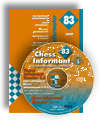 |
Book Reviews |
Last updated 15 July 2002

| index |
Informator 83

by Chess Informant
Introduction
It's been a while since we looked at Chess Informant in the magazine, so I was particularly pleased to receive a review copy of volume 83 (book and CD) from Yugoslavia.
Most serious players know something of the eminence of Chess Informant in the world of chess, but it is still worth reflecting on how they have won their pedigree.
Their objective has always been to capture the games and analysis of the world's best players, and to publish these in a form which transcends language, yet allows systematic classification and reference.
The first volume of Informant was published in September 1966 (rather overshadowing that summer's football sideshow). Between 1966 and 1990, two volumes were produced per annum. From 1991 (volume 51), the production cycle was stepped up to the present three issues each year - in April, August and December.
From the earliest days, the editorial team has taken a far-sighted view of the structure required to underpin their output. They have pioneered four major symbol and classification systems, which most chessplayers will recognise, (if not attribute correctly!):
- Code System - a series of graphics and abbreviations used in annotations. The simpler signs (eg. ! ? + and #) are universally understood, but the extended set requires a special font to display fully.
- Openings Classification - Informant were responsible for the Encyclopaedia of Chess Openings (ECO) system, publishing the first volumes in 1974.
- Endings Classification - Informant led the way here also, with first publication of the Encyclopaedia of Chess Endings starting in 1982.
- Combinations Classification - the first Anthology of Chess Combinations was published by Informant in 1995.
The Book
This is a little larger than most chess books, measuring some 18x25cm, and consisting of 400 pages. The cover gives an indication of its international appeal (9 languages), and boasts the FIDE seal of approval. Its overall appearance is very professional - the fonts are crystal clear, and the binding and finish are handsome.
Contributors to the volume are listed by country and title, and the cast list pretty much replicates the top end of the FIDE grading list - this represents an enormous strength, with about 90% of included games being annotated by the players responsible for making the moves!
Two different editorial boards then vote on material from the previous volume. The first category is the best game from volume 82 (in fact, the top 30 games are ranked), with Kramnik-Anand, Dortmund 2001 hitting the no. 1 spot (according to votes cast by Messrs Chandler, Christiansen, Gurevich, Korchnoi, Matanovic, Piket, Ribli, Shirov and Speelman).
The second category is the award for the most important theoretical novelty (TN) in volume 82. This goes to the Romanian GM Rogozenko for his 14.Qb1!! in the QGD Semi-Slav (D43), after the judges concluded their deliberations (this time the panel consisted of Anand, Bareev, Beliavsky, Benjamin, Yusupov, Lutz, Salov, Sokolov and Timman). The result seems to have spurred Bjelajac to update the opening monograph for D43 on the spot!
The next section is the Code System - some 57 varieties of symbols and abbreviations used in annotating the games.
Then we are into the games themselves - 584 in total, with 643 variations, taken from top-class events and matches played between 1 October 2001 and 31 January 2002. This section accounts for 324 pages out of 400, and, apart from players' and annotators' names, plus playing venues, there is not a word in sight - the chess runes are in total control!
The games are sequenced in ECO order, and are individually highlighted where TNs appear - emboldened if they are deemed significant. A full alphabetical index of players, referenced games/players and annotators is provided at the end of the section.
I agonised for a while over the asterisks set beside each game number, as they hadn't been explained in the Code System.
Eventually it dawned that the number of asterisks corresponded to the numbers of games (or game fragments) referenced by the analysis notes - these games appear as separate entities on the games database provided on the CD. A no-asterisk game makes no external game references, and the analysis consists only of the annotator's notes.
There then follow two sections, firstly a selection of 27 combinations, and then 9 endings, both classified in the Informant manner, which the reader can puzzle over before examining the continuation notes for solutions. Naturally, all players and annotators are dutifully indexed. Endings which were reached in the main games section are also cross-referenced by their Informant codes here.
The tournaments from which the games were selected are tabulated, with results summaries and/or cross tables given as appropriate.
Finally, and complete with caricature, is a section highlighting a featured player (in this case Jan Timman) who has appeared in Informant over the years. True to form, this tailpiece is sectioned by best games, TNs, combinations and endings, with the player's scores and percentages with white and black cross-tabulated against all ECO openings.
The CD
Chess Informant (CI) have exploited the advantages of e-databases and e-books as much as anybody in recent years, and the CD allows you to install two of their proprietary pieces of software.
The first is CI Reader (v2.1), an established product, which gives access to the full range of CI online products - including Informants, ECO volumes, Openings Monographs and Combinations Anthologies. It also offers playing sessions with CI's Crafty, or website access to the CI interactive server.
The second is CI Expert (Lite), currently at Beta test stage, which (I think) is designed to eventually supersede CI Reader. It promises a wider range of file handling capabilities and improved graphics, and is needed at this stage to read the trademark sections of Informant (ie the sections of the book outwith the main games analyses).
Having installed the readers, I then copied in the available publications - Informant 83; the trademark sections of 83; PGN versions (without annotations) of all games from Informants 1-82; and a 500-game Informant demo version.
There's no doubt that the software animates the games, and allows easy branching in and out of the analysed variations. Index sorting and position searches are possible, and the complete database of some 84,000 games is a powerful library in its own right, and can also be used alongside other (non-CI) products.
Export and import of games is via PGN files, though you should note that CI are somewhat jealous about what files you can export - the proprietary elements of Informator and other publications are kept safely under lock and key!
Conclusions
I have to say that, if Chess Informant didn't exist, it would be necessary to invent them!
Their offering is very impressive, and demonstrates the worth of their rigorous development and application of international standards over many years. This discipline and adherence to quality has ensured that their reputation has been well-won, and their standing among the top players testifies to the high esteem in which they continue to be held.
Although the material is from OTB sources, correspondence games are often quoted in the annotations, and CC players can gain much from this source. Serious players will anxious to update their pet lines with the TNs and their supporting analyses provided in Informant, and the Endings classifications will repay study time with interest.
Currently, the book is priced at £18, and the CD at £20.50, with the two together at £22. For my part, if you are a computer user then the CD is a must, so it comes down to whether you want some stylish covers on your bookshelf or not. Chess Informant regularly vary their prices, and you are well advised to periodically consult the Chess Informant website for latest offers and discounts.
I found very little to carp about during my study of the material. The software products didn't seem to like each other being used concurrently, and muttered darkly about their datasets from time to time. They did work well individually though. Presentation quality was excellent whatever the medium, and clearly the editorial team are devoted to exacting standards of production.
If I have a regret, it's that there were no jokes. This is strictly the reference section of the library, and there are no index codes for levity, irrationality or caprice. Without sounding too nihilistic, I wonder if the editors could introduce some further symbols into the Code System?
From some of my recent games I offer the following:
 (I should resign here, but I'm playing on to annoy you)
(I should resign here, but I'm playing on to annoy you)
 (I admire you for keeping a straight face when I play you)
(I admire you for keeping a straight face when I play you)
 (I thought this won when I played it, but I've now seen your reply)
(I thought this won when I played it, but I've now seen your reply)